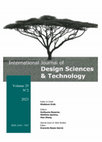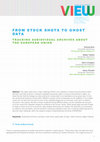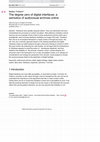Papers by Matteo Treleani
Les cahiers du numérique, 2023
Dans ce texte nous abordons la dimension répétitive et mémorielle des images
de stock dans les mé... more Dans ce texte nous abordons la dimension répétitive et mémorielle des images
de stock dans les médias audiovisuels. D’abord nous proposons une problémati-
sation théorique de ces questions et tentons une définition de la notion d’image
de stock. On présente ensuite un cas d’étude issu du projet ANR CROBORA. À
partir d’un corpus d’environ 22 500 séquences audiovisuelles réutilisées dans les JT
de cinq chaînes françaises et italiennes, nous analysons la représentation visuelle des
migrants en relation avec la thématique Européenne et constatons le renforcement
d’un stéréotype visuel lié à la clandestinité et au voyage en mer. Cela fait suite aux
flux migratoires de 2015 et contribue à la consolidation d’une figure iconique du
migrant exploitée dans d’autres contextes par les actualités télévisuelles.

IJDST International Journal of Design Science and Technology , 2023
How does an image become an emblem representing an event? What is the process that allows a visua... more How does an image become an emblem representing an event? What is the process that allows a visual form to incarnate and reduce the complexity of an event? The paper explores the transformation of a stock shot (the lowering of the Union Jack in front of the European Commission) into a visual form representing the event of Brexit in its entirety. The image circulated widely on TV and on the Web between 2016 and 2021, as observed in the database of the research project CROBORA. We traced the genealogy of this sequence, employing diverse analytical perspectives and methods, including video detection tools. A Sherlock Holmes-style indexical investigation–as Carlo Ginzburg would say–that enabled us to study the path going from genesis to naturalization. Particularly, the circulation of the image is associated with the emotional effects it triggered. Interestingly, the sequence of the Union Jack that circulates most often in the European media is not that of the recording of a ceremony intentionally designed to decree the exit of the UK from the EU, but a generic shot realized several month before the Brexit referendum itself, thus anticipating the event and “premediating” it by waving its specter in front of the public. We show how its circulation creates an emblem by its vast mediatization through the screens.

View. Journal of European Television History and Culture, 2023
This paper deals with a major challenge linked to the collection of audiovisual documents within ... more This paper deals with a major challenge linked to the collection of audiovisual documents within television and web archives. Looking for repeated sequences within a corpus of thousands of videos, we faced the fact that the footage we were looking for reveals itself to be reachable only as ghost data. In fact, any audiovisual sequence reused within different contexts exists conceptually as the repetition of one single visual unit, but also from the point of view of the metadata tagging its occurrences, each item is a distinct document. Like a ghost, the shot is there, scattered among different places, but the metadata cannot point us to the visual form repeated, despite its evidence to the human viewer. When facing large amounts of data, to relate a visual unit to its occurrences, data analysis techniques are needed. We describe our procedures of collection and annotation, and the solutions combining qualitative work and a computer-aided approach to face this main challenge, within the research project Crossing Borders Archives (CROBORA).

Semiotica n. 241, 2021
Interfaces have partially replaced editors. They now administer and have industrialized the proce... more Interfaces have partially replaced editors. They now administer and have industrialized the processes of content circulation.Web platforms mediatize cultural memory and one example of this is that of online audiovisual archives which are a paradigmatic case involving interfaces mediating our image of the past. Therefore, their role as an enunciative framework is clearly worthy of thought and study. We will thus use a semiotic approach based on the starting hypothesis that digital interfaces shape our belief systems through a discursive framing of content to which they give access. By analyzing two case studies, we will argue that the transparency of interfaces appears to recall the notion of “mechanical objectivity” and thus refashion the reliability of the archives. However, a final counter-analysis of a document read in the framework of an on-site consultation invites us to reshape our considerations and enlarge the perspective from semiotic visual analysis to include the social processes linked to the publication of digital heritage.
Scires It, 2021
Recent developments in the technologies of reproducibility have made it possible to experience vi... more Recent developments in the technologies of reproducibility have made it possible to experience visits to heritage sites and artifacts at a distance. These reproductions imply a rearrangement of the space of reception of heritage. This phenomenon can be called relocation. We shall argue that it is a common element to the processes of "patrimonialization" and "mechanical reproducibility". Making-heritage implies a rearrangement of the space around an artifact, this rearrangement also takes place during its mechanical reproduction. In this paper we will discuss some forms of relocations of heritage and see how these phenomena have always been at the heart of practices of valorization of traces of the past. The analysis of a case of virtual reconstitution of an archaeological site will help reveal some of the current trends in this field.
Signata n.12, 2021
1This issue of Signata aims to address the question of the archive from a semiotic and semio-prag... more 1This issue of Signata aims to address the question of the archive from a semiotic and semio-pragmatic perspective. By “semiotics”, we do not mean a single discipline, but rather a plurality of approaches by which to question meaning, forms, and values within the historical, sociological, philosophical, linguistic, media, and artistic disciplines. The aim of this issue is thus the constitution of a cartography that embraces the different approaches that, in the archival field, can elicit reflections pertaining to meaning.
Aldama, F. Nericcio, W. Rafele, A. (eds.) Cultural Studies in the Digital Age, San Diego State University Press, 2021
MEI n. 47, 2019
Cet article entend étudier le dispositif du cinéma à 360 degrés suivant des approches issues de l... more Cet article entend étudier le dispositif du cinéma à 360 degrés suivant des approches issues de la théorie des médias et de la sémiotique de l'énonciation. L'article interroge ce nouveau dispositif entre cinéma traditionnel et réalité virtuelle interactive et ensuite met l'accent sur certaines polarités théoriques qui le concernent comme interaction/ observation et immersion/distanciation. L'analyse d'un film à 360 degrés comme I Philip de Pierre Zandrowicz (2016) nous permettra de questionner de manière plus pertinente les problématiques du cadre, du rapport champ/hors-champ et de la situation énonciative de cette expérience de vision pour ensuite ouvrir vers une première hypothèse sur le geste énonciatif.
Une sémiologie de la circulation des archives. Coll. UDPN, Le Bord de l'Eau, 2017
Chateauvert, J. Delavaud, G. D'un écran l'autre. Les mutations du spectateur. L'Harmattan, Coll. médias en actes., 2016
Coll. Parcours numériques, Les Presses de l'Université de Montréal, May 2014
Preface de Bruno Bachimont
Actes Sémiotiques n. 117, Jan 2014
"Dispositifs numériques : régimes d'interaction et de croyance" Actes Sémiotiques n. 117. PULiM 2014
Ina Global, un autre regard sur les médias, n. 1, 2014, Mar 2014
Être connecté suppose-t-il d'avoir sous les yeux un cadre lumineux ? Matteo Treleani, qui enseign... more Être connecté suppose-t-il d'avoir sous les yeux un cadre lumineux ? Matteo Treleani, qui enseigne à l'Université Paris-Est Marne-la-Vallée, répond par la négative. La métaphore de la fenêtre a peutêtre vécu.
Programme CeRes/Andra 2016, Génèse et devenir de l'information dans le dispositif global. Edition... more Programme CeRes/Andra 2016, Génèse et devenir de l'information dans le dispositif global. Editions Solilang, Limoges
Zetlaoui, Tiphaine (eds.) Histoire(s) de l'Internet. Revue CIRCAV n. 24, L'Harmattan, 2015
Serra, M. y Gomez, O. (eds.) Transparencia y secreto, Visor Libros, Madrid. 2015
Ina Global n.4, Jan 2015
"La technique n'a pas tenu ses promesses de liberté. Entretien avec Gianni Vattimo" Ina Global n.... more "La technique n'a pas tenu ses promesses de liberté. Entretien avec Gianni Vattimo" Ina Global n. 4, mai 2015
"Une sémiotique critique du numérique est-elle possible ?" in Masselot C. et Rasse. P. (dir.) Sci... more "Une sémiotique critique du numérique est-elle possible ?" in Masselot C. et Rasse. P. (dir.) Sciences, technique et société. Recherches sur les technologies digitales. Paris, L'Harmattan, 2015










Uploads
Papers by Matteo Treleani
de stock dans les médias audiovisuels. D’abord nous proposons une problémati-
sation théorique de ces questions et tentons une définition de la notion d’image
de stock. On présente ensuite un cas d’étude issu du projet ANR CROBORA. À
partir d’un corpus d’environ 22 500 séquences audiovisuelles réutilisées dans les JT
de cinq chaînes françaises et italiennes, nous analysons la représentation visuelle des
migrants en relation avec la thématique Européenne et constatons le renforcement
d’un stéréotype visuel lié à la clandestinité et au voyage en mer. Cela fait suite aux
flux migratoires de 2015 et contribue à la consolidation d’une figure iconique du
migrant exploitée dans d’autres contextes par les actualités télévisuelles.
de stock dans les médias audiovisuels. D’abord nous proposons une problémati-
sation théorique de ces questions et tentons une définition de la notion d’image
de stock. On présente ensuite un cas d’étude issu du projet ANR CROBORA. À
partir d’un corpus d’environ 22 500 séquences audiovisuelles réutilisées dans les JT
de cinq chaînes françaises et italiennes, nous analysons la représentation visuelle des
migrants en relation avec la thématique Européenne et constatons le renforcement
d’un stéréotype visuel lié à la clandestinité et au voyage en mer. Cela fait suite aux
flux migratoires de 2015 et contribue à la consolidation d’une figure iconique du
migrant exploitée dans d’autres contextes par les actualités télévisuelles.
This issue proposes to explore the different ontological challenges in the digital age, in an interdisciplinary perspective (welcoming philosophy, aesthetics, literary studies, semiology, sociology , communication.. .). From digital arts to hypermedia literature, via web documentaries and video games, many investigation can be done to explore, understand and go beyond these apparently perilous dichotomies between representation and reality, real and imaginary, fiction and documentary.